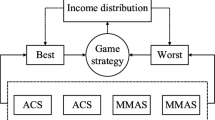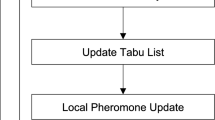Abstract
This work investigates the performance of a hybrid population-based meta-heuristic with an external memory structure of a hybrid elitist-ant system (elitist-AS). This memory is known as an elite pool, which contains high quality and diverse solutions to maintain a balance between diversity and quality of the search. This may guarantee the effectiveness and efficiency of the search, which could enhance the performance of the algorithm across different instances. A very well known and intensively studied NP-hard optimization problem has been selected to test the performance of the hybrid elitist-AS via its consistency, effectiveness and efficiency. This famous problem is the symmetric traveling salesman problem. The elitist-AS is a class of ant colony optimization techniques which are known to be outstanding for the traveling salesman problem where they have the ability to find the shortest tours guided by the heuristic and the pheromone trail information. An iterated local search is combined with elitist-AS to intensify the search around elite solution and maintains the solution’s exploitation mechanism. Experimental results showed that the performance, compared to the best known results, is optimal for many instances. This finding indicates the effectiveness, efficiency and consistency in diversifying the search while intensifying high-quality solutions. This outstanding performance is due to the utilization of an elite pool along with diversification and intensification mechanisms. In addition, this work proposes two instances that consist of 26 Jordanian cities and 1094 Jordanian locations which have been generated based on coordinates and distances similar to the format of the selected symmetric traveling salesman problem. This step is meant to contribute to finding a solution for a real-world problem and further test the performance of the hybrid elitist-AS.





Similar content being viewed by others
Notes
Coordinates and distances data were collected from the Ministry of Tourism and the Royal Geographic Centre in the Hashemite Kingdom of Jordan.
OR library website: http://comopt.ifi.uni-heidelberg.de/software/TSPLIB95/.
References
Albayrak M, Allahverdi N (2011) Development a new mutation operator to solve the traveling salesman problem by aid of genetic algorithms. Expert Syst Appl 38(3):1313–1320
Bao H (2015) A two-phase hybrid optimization algorithm for solving complex optimization problems. Int J Smart Home 9(10):27–36. doi:10.14257/ijsh.2015.9.10.04
Bouzidi M, Riffi ME (2014) Adaptation of the harmony search algorithm to solve the travelling salesman problem. J Theor Appl Inf Technol 62(1):154–160
Blum C, Roli A (2008) Hybrid metaheuristics: an introduction, studies in computational intelligence. In: Blum C, Aguilera MJB, Roli A, Samples M (eds) Hybrid metaheuristics: an emerging approach to optimization, vol 114. Springer, Berlin, pp 1–30
Dong G, Guo W (2010) A cooperative ant colony system and genetic algorithm for TSPs. ICSI 1:597–604
Dorigo M, Di Caro G, Gambardella LM (1999) Ant algorithms for discrete optimization. Artif Life 5:137–172
Dorigo M, Maniezzo V, Colorni A (1991) Positive feedback as a search strategy. Technical Report 91-016, Dipartimento di Elettronica e Informazione, Politecnico di Milano, Italy
Dorigo M, Stützle T (2010) Ant colony optimization: overview and recent advances. In: Gendreau M, Potvin J-Y (eds) Handbook of metaheuristics, international series in operations research & management science, Chapter 8, vol 146. Springer, Berlin, pp 227–263
Glover F, Laguna M, Martí R (2002) Scatter search. In: Ghosh A, Tsutsui S (eds) Theory and applications of evolutionary computation: recent trends. Springer, Berlin, pp 519–529
Greistorfer P, Voß S (2005) Controlled pool maintenance in combinatorial optimization. In: Rego C, Alidaee B (eds) Conference on adaptive memory and evolution: tabu search and scatter search, Chapter 18, University of Mississippi, Kluwer Academic Publishers, pp 387–424
Jaradat G, Ayob M (2010) An elitist-ant system for solving the post-enrolment course timetabling problem. In: Zhang Y et al (eds) DTA/BSBT 2010, vol 118. Springer, Heidelberg, pp 167–176
Karaboga D, Gorkemli B (2011) A combinatorial artificial bee colony algorithm for traveling salesman problem. In: 2011 international symposium on innovations in intelligent systems and applications (INISTA), pp 50–53
Li B, Wang L, Song W (2008) Ant colony optimization for the traveling salesman problem based on ants with memory. In: Fourth international conference on natural computation, IEEE 978-0-7695-3304-9/08. doi:10.1109/ICNC.2008.354
Marinakis Y, Marinaki M (2010) A hybrid genetic—particle swarm optimization algorithm for the vehicle routing problem. Expert Syst Appl 37:1446–1455
Montgomery J, Randall M (2003) The accumulated experience ant colony for the travelling salesman problem. Int J Comput Intell Appl 3(2):189–198
Osaba E, Yang XS, Diaz F, Lopez-Garcia P, Carballedo R (2016) An improved discrete bat algorithm for symmetric and asymmetric Traveling Salesman Problems. Eng Appl Artif Intell 48:59–71
Osman IH, Kelly JP (1996) Meta-heursitic: an overview. In: Osman IH, Kelly JP (eds) Meta-heuristic: theory and applications. Kluwer Academic Publishers, Berlin
Ouaarab A, Ahiod B, Yang X-S (2014) Discrete cuckoo search algorithm for the travelling salesman problem. Neural Comput Appl 24:1659–1669
Pantrigo JJ, Duarte A, Sánchez Á, Cabido R (2005) Scatter search particle filter to solve the dynamic travelling salesman problem. In: GR Raidl, J Gottlieb (eds) EvoCOP 2005. LNCS 3448:177–189
Puris A, Bello R, Martinez Y, Nowe A (2007) Two-stage ant colony optimization for solving the traveling salesman problem. Mira J, Alvarez JR (eds) IWINAC 2007, Part II. LNCS 4528:307–316
Puris A, Bello R, Herrera F (2010) Analysis of the efficacy of a Two-Stage methodology for ant colony optimization: case of study with TSP and QAP. Expert Syst Appl 37:5443–5453
Reinelt G (1991) TSPLIB-a travelling salesman problem library. ORSA J Comput 3:376–384
Reinelt G (1995) The TSPLIB symmetric traveling salesman problem instances. http://elib.zib.de/pub/mp-testdata/tsp/tsplib/tsp/index.html
Rodriguez A, Ruiz R (2012) The effect of the asymmetry of road transportation networks on the traveling salesman problem. Comput Oper Res 39(7):1566–1576
Szeto WY, Wu Y, Ho SC (2011) An artificial bee colony algorithm for the capacitated vehicle routing problem. Eur J Oper Res 215(1):126–135
Talbi EG (2009) Metaheuristics: from design to implementation. Wiley, USA
Wang Y (2014) The hybrid genetic algorithm with two local optimization strategies for traveling salesman problem. Comput Ind Eng 70:124–133
Wang Y, Tian D, Li YH (2013) An improved simulated annealing algorithm for travelling salesman problem. Int J Online Eng 9(4):28–32
Yang JH, Wu CG, Lee HP, Liang YC (2008) Solving traveling salesman problems using generalized chromosome genetic algorithm. Prog Nat Sci 18:887–892
Author information
Authors and Affiliations
Corresponding author
Ethics declarations
Conflict of interest
The author declares that he has no conflict of interest.
Rights and permissions
About this article
Cite this article
Jaradat, G.M. Hybrid elitist-ant system for a symmetric traveling salesman problem: case of Jordan. Neural Comput & Applic 29, 565–578 (2018). https://doi.org/10.1007/s00521-016-2469-3
Received:
Accepted:
Published:
Issue Date:
DOI: https://doi.org/10.1007/s00521-016-2469-3




